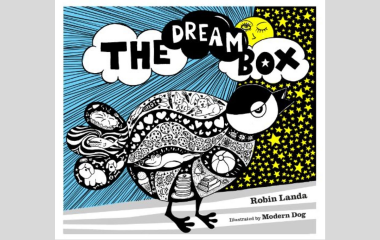A noted branding and creativity strategist, Robin Landa has written more than a dozen books about graphic design and advertising. Her latest work, the children’s picture book The Dream Box, ventures into new territory. Yet she found the inspiration for her story right at home.
“When my daughter, Hayley, was about 3 years old, she had a few nightmares,” explained Landa. “I remembered she had a toy fishing-tackle box with a lid. I presented this toy to Hayley as the Dream Box.”
Landa gave her daughter some simple instructions. First, speak her nightmares into the box. Then close the lid. Finally, order her bad dreams to stay there.
“After using the Dream Box several times, Hayley was no longer plagued by nightmares, and we all got some sleep,” Landa said.
Landa realized that this simple technique could help others too. So she decided to write a “problem-solving story disguised as a picture book.” The Dream Box was born.
The Kindle e-book focuses on Alex, a young bird with some crazy dreams. Ninja frogs. Triple-eyed toads. Giant pancakes. He’s practically scared out of his feathers.
Alex decides he has only one way to fight back: He’s never going to sleep again. It’s a tough task for the bleary-eyed bird.
He receives some trite advice from well-meaning family members. But Alex knows that it doesn’t help to think “nice things” and “happy thoughts.” He needs a real solution.
That’s when he finds a curious little box on his bed. A note with the box helps Alex kick his uninvited guests out of his dreams.
Most children – and parents – should be able to relate to Alex’s problem. The American Academy of Sleep Medicine reports that nightmares usually start between the ages of 3 and 6 years. Nightmares typically peak around 6 to 10 years of age.
Young children will get a kick out Alex’s wild dreams. They also will enjoy the lively, dynamic illustrations created by Modern Dog Design Co. A note from Alex at the end of the book encourages children to make their own Dream Box.
But can a Dream Box really work? Nightmares are greatly influenced by psychological factors. So a cognitive or behavioral intervention can be an effective form of treatment.
One example is imagery rehearsal therapy. IRT involves changing the theme, storyline or ending of a dream to make it more positive. Having children draw modified pictures of their nightmares may reduce their distress.
So a Dream Box might do the trick for a simple case of bad dreams. But a severe nightmare problem may require professional help. Talk to your child’s doctor if disturbing nightmares occur frequently. For an ongoing problem you may want to contact a behavioral sleep medicine provider.





